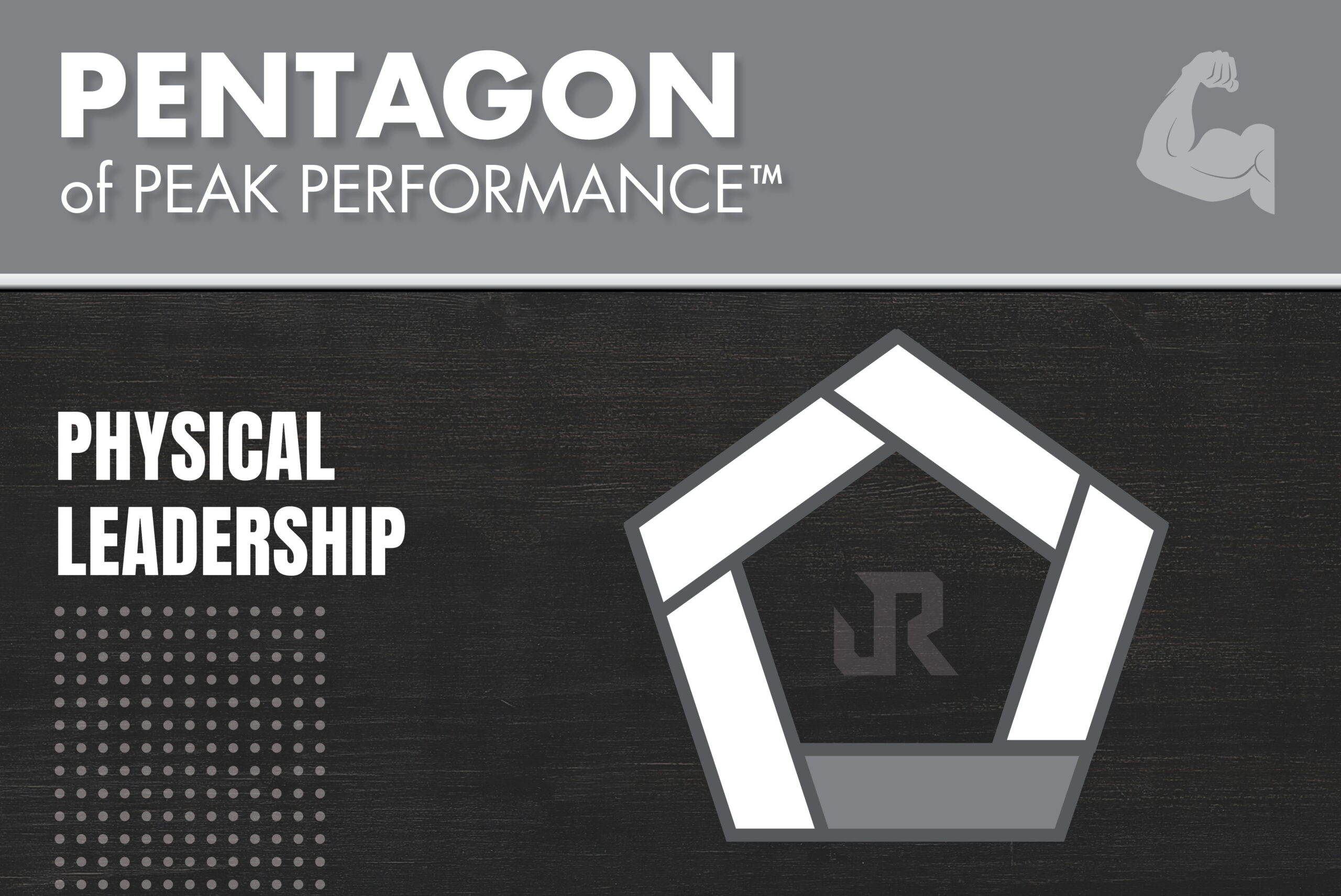Of all that transpired to save my life during and after that enemy ambush Sept. 13, 2007, only two had been within my control: my “overcome” mindset to get off the X and, according to the medical teams who put me back together in the aftermath, my rock-solid physical fitness, which had prepared my body for its best chance at survival and healing through the extreme compound trauma.
In fact, when I got wounded, I was incredibly strong in all five key areas of my life that I now refer to as the Pentagon of Peak Performance. In Part One of this series, I introduced the Pentagon: a conceptual model for building yourself up within the five foundational areas of life which everything else you attempt to build, both personally and professionally, will rely on for stability, resiliency, longevity and optimal development. The model promotes relentless focus on self-leadership first, as the quality of our leadership in any field or endeavor always ultimately depends upon how well we lead ourselves. Great self-leadership results in effective leadership of others; poor self-leadership results in ineffective leadership of others.
The Pentagon of Peak Performance comprises Physical Leadership, Mental Leadership, Emotional Leadership, Social Leadership and Spiritual Leadership — the key areas of my life that I know, when they are well-fortified, enable me to be the happiest and most focused, balanced, successful and “ready for any life ambush that comes my way” man and leader I can be. And when that enemy ambush got me, it almost got my life. But I had already built so much strength in mind and body, that I was, quite literally, ready for anything.
Granted, that’s a pretty high standard to be aiming to meet in any given week, but I’m on a mission — in business and in life — every day. And granted, some days are “easier” than others. But the standard is always relative: Be the best I can be where I stand right now, with what I have cultivated to this point, and, as we say in the special-operations world, “The only easy day was yesterday,” so be prepared to do your best today.

That’s important for all of us to remember, because our “best life” is not attained by futile attempts to jump from Point A to Point Z or shame-based pursuit of what we believe we should have achieved by now “if only …”. Instead, it’s attained by developmental progress through self-discipline and perseverance. And progress can’t possibly begin anywhere else but with the next step, or “moving the needle,” along the course of your ultimate goal. That’s self-leadership. And in the Pentagon of Peak Performance, self-leadership begins with Physical Leadership.
Physical Leadership: The First Building Block of Strength, Balance and Resiliency
If Physical Leadership hasn’t already been a consistent focus for you; if your current level of fitness is more likely to hinder your performance and experience in other areas of your life than it is to actually save your life in a major crisis or “life ambush,” I recommend you make it your primary goal starting today.
Maintaining high-level Physical Leadership is one of the most important things you can do for yourself and those who depend upon you. It will enable optimal personal and professional performance on any “normal” day as it contributes to the quality of strength, vitality, endurance, disease-immunity, cognitive ability, stress-mitigation, interpersonal relations, and overall bodily, mental and emotional health you experience, and it’s an essential component to readiness for times of crisis.
To get on track:
- Define three long-term goals for specific improvements in your overall Physical Leadership and fitness over a specific course of time (consider six months or one year). They must be realistic, achievable, measurable and (reasonably) adaptable. In my Pointman programs, which include a focus on both the Pentagon of Peak Performance and effective goal-setting, I refer to important long-term goals as Destinations and the shorter-term goals required to reach on the way as a set Course of waypoints.
- Focusing on the three primary components to Physical Leadership (physical fitness/activity, nutrition and sleep), determine and list what’s necessary on your part to achieve these long-term goals, or arrive at those Destinations.
- Guided by your list, set your Course of shorter-term objectives, or waypoints, to meet (I often use a quarterly/12-week timeline for these) for progress and development in each of those areas.
- Support your no-excuses mindset to stay the course: Schedule daily and weekly time, attention and discipline for “moving the needle” every day for ongoing incremental progress along the course to achieving those short- and long-term goals.
For instance, if your long-term goals include losing 25 pounds, completing a marathon within a specified run-time, leveling up to some other pre-determined athletic or fitness achievement, and adding two hours of energized, meaningful productivity or play time to each day, all within a six-month timeline, examples of quarterly waypoints may include: completing a half-marathon at the pace of your choice by end of quarter one, losing four pounds per month, maintaining a specific workout and nutrition routine, increasing energy and muscle tone/mass to a specific mark and getting at least seven hours of quality sleep nightly.
To achieve all that, you’ll need to prepare for success by moving the needle every day. Your first month could include walking/running 10 or 20 miles a week, strength and cardio training at the gym three evenings a week, preparing healthy meals at home, avoiding sugar and processed foods, limiting alcohol consumption, not eating after 7 p.m., getting to bed by 9:30 p.m., and waking up at 5:00 a.m. to focus specifically on accomplishing one most-important, no-excuses move-the-needle item before starting the day.
Ready? Go!
Determine your long-term goals and what you need to do over the appropriate course of time to achieve them. Then flesh out and stick with a daily/weekly schedule to move the needle for incremental positive progress every day, toward reaching each waypoint, for big results in the end.
Destination – Long-term Physical Leadership goals for the next _____-month period:
_______________________________________________________________________________________
_______________________________________________________________________________________
_______________________________________________________________________________________
Waypoint – Fitness/activity goals for next four weeks: ______________________________
“Moving the Needle” – Daily progress actions (list ideas you can schedule into the week ahead):
Waypoint – Nutrition goals for the next four weeks: _______________________________
“Moving the Needle” – Daily progress actions (list ideas you can schedule into the week ahead):
Waypoint – Sleep goals for the next four weeks: __________________________________
“Moving the Needle” – Daily progress actions (list ideas you can schedule into the week ahead):
In time, living our “best life” will be determined by how we persevere in leading ourselves to envision and plan our missions, navigate the courses, breach the barriers and move the needle in order to build who we want to be and what we aim to leave for the potential betterment of others.
My best life is always under construction. And the older I grow, the more I understand that all that is required of me to achieve my goals, to meet my standards, and to live my missions is to accept personal responsibility for and leadership within the Pentagon of Peak Performance.
By investing in these same areas in your own everyday life, you, too, can be a better, more well-rounded leader, prone to experiencing more joy and satisfaction in life and also better equipped to handle any crisis, adversity or life ambush that may lurk on the horizon.
Next stop: Mental Leadership.
Want more? Choose your weapon:
- A recent Monday Muster for my Overcome Army members addressed Physical Leadership. Watch it here.
- Define or redefine your personal or business “Mission,” starting with some guidance here.
- Download these helpful introductions to my REACT Methodology and LEARN to Lead concept and begin applying them in the days and weeks ahead.
- Catch up on my last series, Leadership and Change Management in Business, beginning with Part 1: Adapting Quickly as a Leadership Skill.
For extra support, check out my group and individual coaching options at www.getoffx.com, get a copy of my new Pointman Planner or learn more about my 72 Hours to Peak Performance ($49.99) and How to Build the Overcome Mindset ($29.99) online courses.
Until then …
“Lead Always and Overcome All,”
Jason Redman
Since retiring in 2013 from my 21-year U.S. Navy SEAL career, I’ve made it my mission to transfer my military leadership training, experience and skills to helping individuals and organizations to lead and launch themselves and their teams to elite performance. I accomplish this through an array of speaking topics, courses, books and coaching programs I’ve developed based largely upon proven SEAL and special-operations mission-centric and leadership techniques.
How can I be of service to you or your organization?
For information about my speaking offerings, visit www.jasonredman.com
Nearly all the topics covered in this series are also currently or soon-to-be available in an array of coaching programs, online courses and books, including bestsellers “The Trident: The Forging and Reforging of a Navy SEAL Leader,” “Overcome: Crush Adversity With the Leadership Techniques of America’s Toughest Warriors” and new Pointman Planner. Visit: www.getoffx.com



